Do Plants Breathe
- Books Name
- ACME SMART COACHING Biology Book
- Publication
- ACME SMART PUBLICATION
- Course
- CBSE Class 11
- Subject
- Biology
Do Plants Breathe
Plants require oxygen for respiration to occur and they also give out carbon dioxide . Hence , plants have systems in place that ensure the availability of oxygen . Plants , unlike animals , have no specialised organs for gaseous exchange but they have stomata and lenticels for this purpose .
> There are several reasons why plants can get along without respiratory organs . First , each plant part takes care of its own gas - exchange needs . There is very little transport of gases from one plant part to another . Second , plants do not present great demands for gas exchange . Roots , stems and leaves respire at rates far lower than animals do . Only during photosynthesis large volumes of gases are exchanged and each leaf is well adapted to take care of its own needs during these periods . When cells photosynthesise , availability of oxygen is not a problem in these cells since oxygen is released within the cell . Third , the distance that gases must diffuse even in large , bulky plants is not great . Each living cell in a plant is located quite close to the surface of the plant .
> This is facilitated by the loose packing of parenchyma cells in leaves , stems and roots , which provide an interconnected network spaces The complete combustion of glucose , which produces CO₂ and H₂O as end products , yields energy most of which is given out as heat .
> The strategy that the plant cell uses is to catabolise the glucose molecule in such a way that not all the liberate energy goes out as heat . The key is to oxidise glucose not in one step but in several small steps enabling some steps be just large enough such that the energy released can be coupled to ATP synthesis . During the process of respiratio oxygen is utilised and carbon dioxide , water and energy are released as products .
Glycolysis
- Books Name
- ACME SMART COACHING Biology Book
- Publication
- ACME SMART PUBLICATION
- Course
- CBSE Class 11
- Subject
- Biology
Glycolysis
Most ancient metabolic pathway with the sequence of reactions which converts glucose to pyruvic acid with the production of ATP is termed as glycolysis.
It is an anaerobic process, i.e., it does not require oxygen and is common to both aerobic and anaerobic respiration.
Therefore, it is regarded as the fundamental step in respiratory breakdown of glucose.
It is the only process in respiration among anaerobes.
Glycolysis involves a series of ten reactions, which were elucidated by three scientists - Embden, Meyerhof and Parnas, thus also known as EMP pathway.
These reactions occur in the cytoplasm of cells and do not required oxygen.
The first half of this pathway activates glucose (glucose activation phase).
The second half extracts the energy (energy extraction phase).
Glycolysis yields only 5% of total ATP production and less than 7 % of total energy content of glucose.
Special features of glycolysis can be summarised as follows:
(1) Each molecule of glucose produces 2 molecules of pyruvic acid after partial oxidation, at the end of the glycolysis.
(2) The net gain of ATP in this process is 2 ATP molecules four ATPs are formed in glycolysis but two are already used up in the reaction).
(3) During the conversion of 1,3-diphosphoglyceraldehyde into 1,3-diphosphoglyceric acid, one molecule of NADH2 is formed. As each molecule of glucose yields two molecules of 1, 3-diphosphoglyceric acid, hence, each molecule of glucose forms 2 molecules of NADH2.
(4) During aerobic respiration (when oxygen is available) eachNADH2 forms 3ATP and H2O through electron transport system of mitochondria. In this process 1/2 O2 molecule is utilized for the synthesis of each water molecule.
All the reactions of EMP are reversible except for those catalysed by Hexokinase, Phosphofructokinase and Pyruvic kinase.
Nearly all enzymes require Mg+2 as cofactor.
Brain, retina and skin derive most of their energy from glycolysis.
It is the only source of energy in RBC.
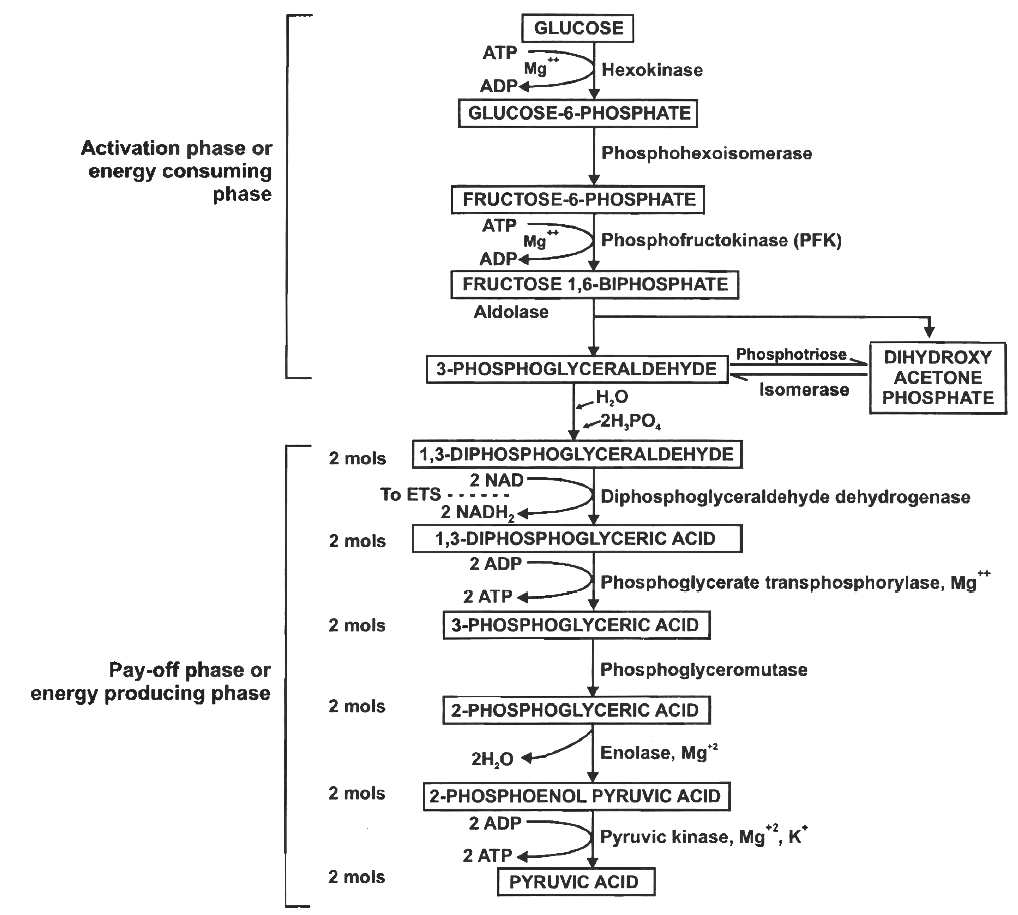
Summary of glycolysis
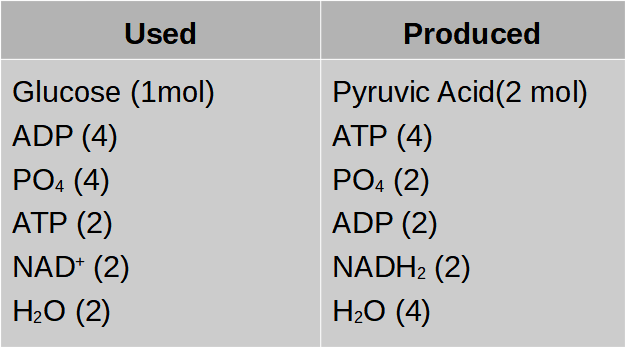
Fermentation
- Books Name
- ACME SMART COACHING Biology Book
- Publication
- ACME SMART PUBLICATION
- Course
- CBSE Class 11
- Subject
- Biology
Fermentation
Fermentation is a kind of anaerobic respiration, carried out primarily by fungi and bacteria.
Although people had been using this process in the preparation of wines since prehistoric times but failed in their attempts to understand the alcoholic fermentation.
Gay Lussac was the first to discover fermentation.
Louis Pasteur concluded that fermentation occurred only when the living yeast cells were present and called this process as zymosis or fermentation.
Fermentation is of following types:
Types of anaerobic respiration and fermentation (Also called intramolecular respiration):
1. Alcoholic fermentation/anaerobic respiration:
It is the most common type of fermentation taking place in yeast and certain bacteria.
Buchner (1897) extracted zymase complex (enzymes) from yeast cells.
Fermentation takes place in the solution of large numbers of sugars, like fructose, galactose, mannose and disaccharides.
In fermentation by yeast, when percentage of alcohol in sugar solution is about 13%, yeast cells are killed and fermentation stops.
At the time of germination of seeds the amount of sugar increases, so that fermentation takes place in germinating grains of barley.
Alcoholic fermentation takes place in two steps.
In the first step, pyruvic acid is decarboxylated resulting in the formation of acetaldehyde and CO2.![]()
In the second step, acetaldehyde is reduced to alcohol by 2NADH + 2H+
![]()
The overall equation is as follows:
![]()
2. Lactic acid fermentation: Pyruvic acid formed at the end of glycolysis is converted to lactic acid by Homofermentative lactic acid bacteria (Lactobacillus lacti)
![]()
3. Lactic acid and ethyl alcohol fermentation
![]()
4. Acetic acid fermentation
(i) ![]()
(ii) ![]()
Comparison of fermentation and aerobic respiration
(i) Partial breakdown of glucose occurs in fermentation, whereas in aerobic respiration it is completely degraded to CO2 and H2O.
(ii) Net gain if only 2ATP molecules in fermentation, whereas it is very high in aerobic pathway.
(iii) NADH is oxidised to NAD+ rather slowly during fermentation, however, the reaction is very vigorous in case of aerobic respiration.
Aerobic Respiration
- Books Name
- ACME SMART COACHING Biology Book
- Publication
- ACME SMART PUBLICATION
- Course
- CBSE Class 11
- Subject
- Biology
Aerobic Respiration
Aerobic respiration is a process in which there is a complete oxidation of organic substances in the presence of oxygen and releases CO₂ , water and a large amount of energy present in the substrate . This type of respiration is most common in higher organisms .
The aerobic respiration takes place in the mitochondria .The final product of glycolysis , pyruvate is transported from the cytoplasm into the mitochondria .
The crucial events in aerobic respiration are :
( i ) The complete oxidation of pyruvate by the stepwise removal of all the hydrogen atoms , leaving three molecules of CO2
( ii ) The passing on of the electrons removed as part of the hydrogen atoms to molecular O₂ with simultaneous synthesis of ATP
The first t process takes place in the matrix of the mitochondria while the second process is located on the inner membrane of the mitochondria .
Pyruvate oxidation : Pyruvate , the end product of glycolysis enters mitochondrial matrix through a specific transport protein . It is decarboxylated oxidatively to produce CO₂ and NADH . The product combines with sulphur containing coenzyme A to form acetyl CoA or activated acetate . The reaction occurs in the presence of an enzyme complex pyruvate dehydrogenase . This step is called gateway step or link reaction because acetyl CoA acts as a connecting link between glycolysis and Krebs ' cycle .
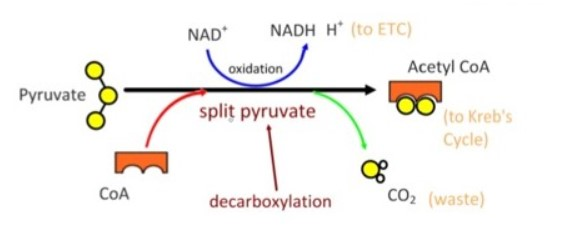
The Respiratory Balance Sheet
- Books Name
- ACME SMART COACHING Biology Book
- Publication
- ACME SMART PUBLICATION
- Course
- CBSE Class 11
- Subject
- Biology
The Respiratory Balance Sheet
It is possible to make calculations of the net gain of ATP for every glucose molecule oxidised; but in reality this can remain only a theoretical exercise.
These calculations can be made only on certain assumptions that:
There is a sequential, orderly pathway functioning, with one substrate forming the next and with glycolysis, TCA cycle and ETS pathway following one after another.
The NADH synthesised in glycolysis is transferred into the mitochondria and undergoes oxidative phosphorylation.
None of the intermediates in the pathway are utilised to synthesise any other compound.
Only glucose is being respired -no other alternative substrates are entering in the pathway at any of the intermediary stages.
ATP molecules produced during respiration
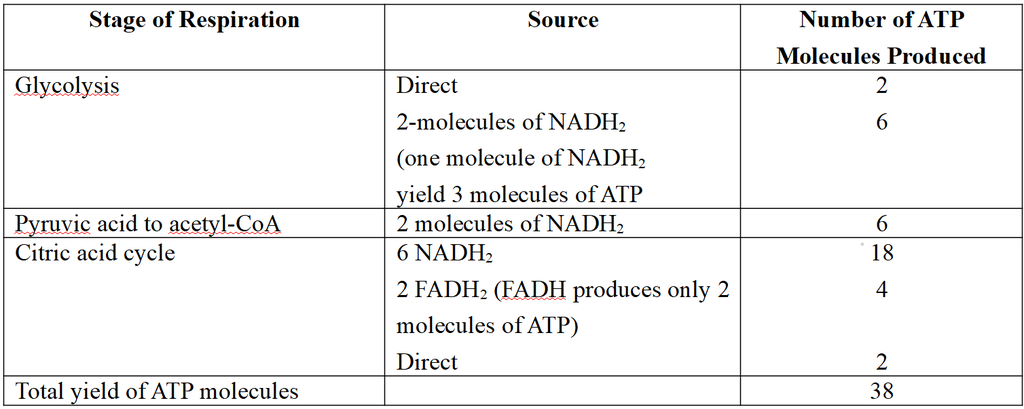
Net Gain of ATP
There is a net gain of 38 ATP molecules during aerobic respiration of one molecule of glucose.
The details of ATP produced have been given in the above table.
In most eukaryotic cells the net gain of ATP is 36 molecules.
Efficiency of Aerobic Respiration
(i) One ATP yields about 34 kJ energy.
(ii) Total energy obtained from 38 ATP moelcule is 1292 kJ. The glucose molecules stores energy of about 2870 kJ.
(iii) Efficiency = ![]() = 45%
= 45%
why respiration is amphibolic?
- Books Name
- ACME SMART COACHING Biology Book
- Publication
- ACME SMART PUBLICATION
- Course
- CBSE Class 11
- Subject
- Biology
Amphibolic Pathway
glucose is the favoured substrate for respiration . All carbohydrates are usually first converted into glucose before they e used for respiration .
Other respired , but they do not enter the respiratory pathway at the first step .
Fats would need to be broken down into glycerol and fatty acids first . If fatty acids were to be respired they would first be degraded to acetyl CoA and enter the pathway . Glycerol would enter the pathway after being converted to PGAL . The proteins would be degraded proteases and the individual amino acids ( after deamination ) depending on their structure would enter the pathway at some stage within the Krebs ' cycle or even as pyruvate or acetyl CoA .
Since respiration involves breakdown of substrates , the respiratory process has traditionally been considered a catabolic process and the respiratory pathway as a catabolic pathway . But this is not completely true .
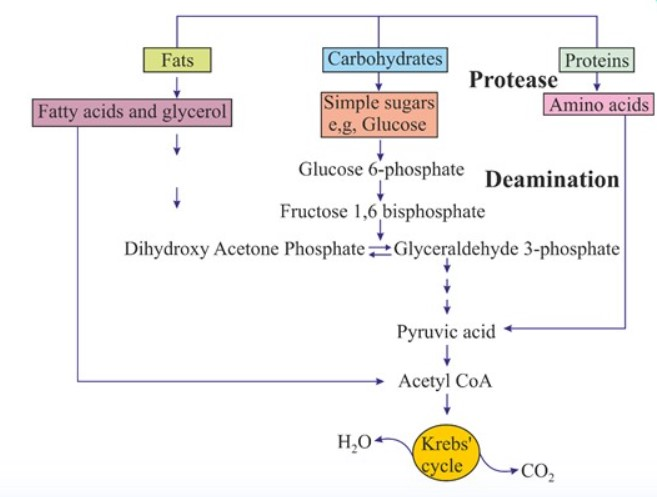
> When the organism needs to synthesise fatty acids , acetyl CoA would be withdrawn from the respiratory pathway for it . Hence , the respiratory pathway comes into the picture both during of fatty acids . Similarly during breakdown and synthesis of protein too , respiratory form the link .
> Breaking down processes within the living organism is catabolism and synthesis is anabolism . Because respiratory pathway is involved in both anabolism and catabolism , it would hence be better to consider the respiratory pathway as an amphibolic pathway .
Respiratory Quotient
- Books Name
- ACME SMART COACHING Biology Book
- Publication
- ACME SMART PUBLICATION
- Course
- CBSE Class 11
- Subject
- Biology
Respiratory Quotient
Respiratory quotient (RQ) or respiratory ratio is the ratio of the volume of carbon dioxide released by a tissue over a period of time to the volume of oxygen absorbed during this period.
RQ = ![]()
The respiratory quotient, besides other factors, depends upon the type of respiratory substrate and the completeness of oxidation.
It can be measured with the help of an apparatus called Ganong's respirometer.
The value of RQ may be equal to unity, more than unity or less than unity, depending upon the substrates oxidised.
This can be illustrated by following examples:
(i) In case of carbohydrates : Plant material where carbohydrates serve as the respiratory substrates (e.g., germinating seeds of cereals, leaves kept in dark, flowers and fruits rich in carbohydrates) have RQ equal to unity, i.e., one.
C6H12O6 + 6O2 ® 6CO2 + 6H2O
RQ = ![]() = 1
= 1
(ii) In case of fats: e.g. , In germinating fatty seeds (e.g., castor, sesame, mustard, linseed, etc.) Fats are poor in structural O2, so the RQ value is less than unity.
2C51 H98O6 + 145O2 ® 102CO2 + 98H2O
(tripalmitin)
RQ = ![]() = 0.7
= 0.7
(iii) In case of proteins -e.g., germinating pulse seeds.
In proteins too, the proportion of carbon is more than oxygen, hence their RQ is also less than unity i.e., (0.5 -0.9).
(iv) In succulents (during night) e.g., Bryophyllum, Opuntia
Incomplete oxidation of carbohydrates occurs during night when stomata are open.
3C6H120 6 + 3O2 —® 3C4H6O5 + 3H2O
RQ = ![]() = 0
= 0
(v) In case of organic acids. In fleshy plants (i.e., members of Cactaceae and Crassulaceae) the organic acids (such as malic acid, oxalic acid, etc.) are produced during night are oxidised during day time. Organic acids contain high proportion of oxygen as compared to carbohydrates, therefore, less oxygen is absorbed than CO2 liberated. The RQ value is more than unity.
e.g., The RQ value is 4 for oxalic acid and 1.33 for malic acid
(vi) In case of'anaerobic condition (in the absence of O2). In the absence of oxygen, tissue respires anaerobically. Thus, CO2 liberation takes place without any utilization of oxygen.
e.g., ![]()
RQ = ![]() = ∞ (Infinite)
= ∞ (Infinite)
(vii) R Q. of maturing fatty seed is > 1.
(viii) RQ. of mixed diet is 0.85.
(ix) RQ. of starved leaves is < 1.
(x) RQ. of coloured petals < 1.

 ACME SMART PUBLICATION
ACME SMART PUBLICATION
